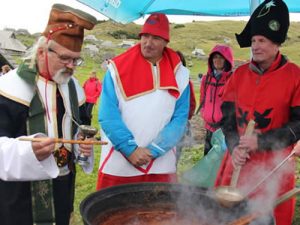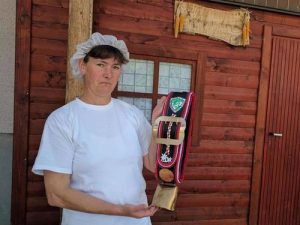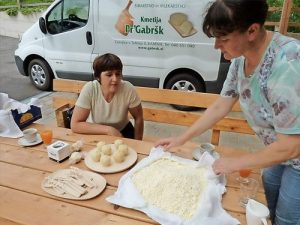The shepherd settlement of Velika planina is considered one of the best preserved settlements of its size in Europe. It has a long history and tradition that goes back to the Middle Ages. The shepherd’s settlement is protected as a cultural monument and is recognizable through its typical architecture. At the end of the last century, this agrarian community became the owner of common land (commonage), which was previously state owned. Since then the community has gained more influence on the development of the mountain. The number of animals on the mountain is growing alongside with tourism. Velika planina is one of the most recognizable tourist destinations in Slovenia. Farmers joining the Agrarian community manage to maintain a balance between tradition and development, primarily through their own resources and work, and without much financial assistance from the state or local municipality.
Area: 500 ha
There are 64 grazing beneficiaries on the mountain, which covers approximately 500 ha of land in total. Beneficiar- ies come from 13 different villages in the valley and at the beginning of June about 33 shepherds with around 400 animals go to the mountain. They spend three months there. On the mountain, various breeds of cattle are reared with the cika being a prominent example, the only autochthonous Slovenian cattle breed. There are mostly young animals, suckling cows with calves and few milking cows whose milk and dairy products are intended for sale to visitors to the mountains. The processing of milk was not a traditional activity in Velika planina, with the exception of the production of Trnič cheese. The number of animals on the mountain has increased in recent years. The reason is partly to the abandonment of milk production and increased popularity of suckling cows, and partly because of the economic crisis, when local inhabitants started to recommence work on their farms again.
Cooperation Process Data
Agrarian community - Grazing community Velika planina is mostly financed by members’ funds. Only a minority of financial resources are contributions from the municipality. As a community, they cannot apply for grants from the Rural Development Program. Together with other agrarian communities in Slovenia, they seek to adjust agricultural policy and measures in such a way that the agrarian communities can compete for the funds from the Rural Devel- opment Program.
Certain funds from the rural development program can be obtained by individual farmers through direct payments and only for areas with difficult production conditions.
Communicating and coordinating the interests of community members is a demanding task. Pasture rights are inherited, and they can cross over to many successors, who often have contradictory interests. The functioning of the community is also difficult because of inactive members who do not participate in the work of the community in accordance with its rules.
Communication and co-ordination of interests with other stakeholders in the area managed by the community is also demanding. These stakeholders include: tourist workers, nature conservationists, cultural heritage managers, and hunters.
Long-standing and complicated administrative procedures are seen as an obstacle to the operation and develop- ment of the mountain community.
The agrarian and grazing communities have only recently received an appropriate legal status. Their performance de- pends on the ability, ingenuity and experience of the management and members. In its program, the advisory service does not provide special education / training for agrarian and grazing communities. The Agricultural Chamber has prepared a special Handbook for the operation of agrarian communities, which focuses only on legal and tax aspects of operations. No education is available to leaders and members of the community, which includes topics such as; communication, management and conflict resolution skills.
As individuals - farmers - they have a lot of education available to them through the Agricultural Advisory Service. These are professional education and training in the field of agricultural policy measures or from various other legal areas (taxes, inheritance, safe food, nature protection). Some education is also mandatory for individual farmers. Compulsory education among farmers is not popular. Soft skills such as communication, management, conflict res- olution are most likely to be learned through exchange of experiences and examples of best practices.
Advice/Recommendation
"You should have a good relationship with members and other stakeholders and institutions."
Queries/Questions
- Should leaders and members of agrarian communities learn the skills of proper communication, management and conflict resolution?
- What would be the most appropriate way for farmers to acquire knowledge and skills?
- Who should be responsible for providing training to farmers?



 Čeština
Čeština  English
English  Français
Français  Deutsch
Deutsch  Italiano
Italiano  Slovenščina
Slovenščina  Español
Español 



